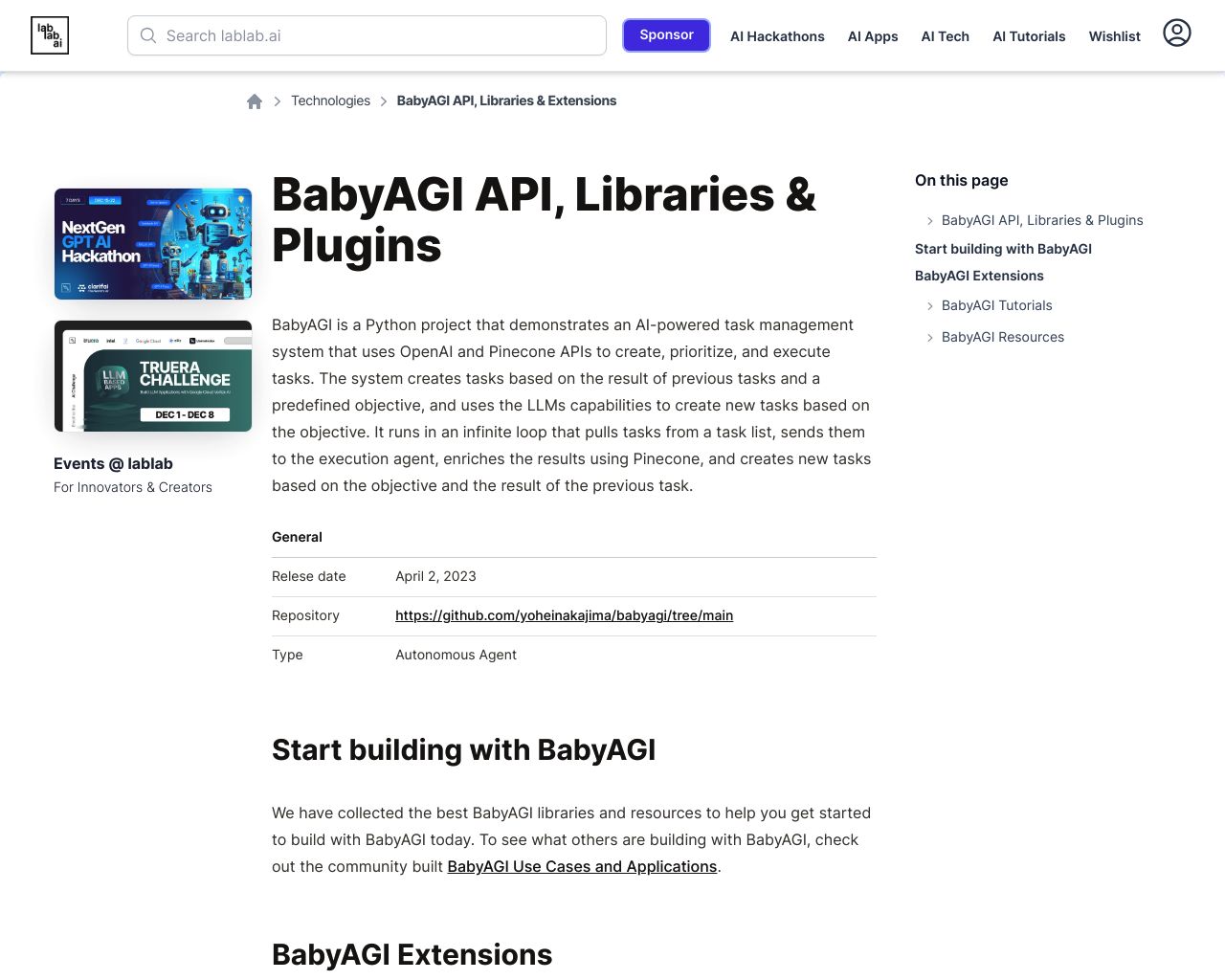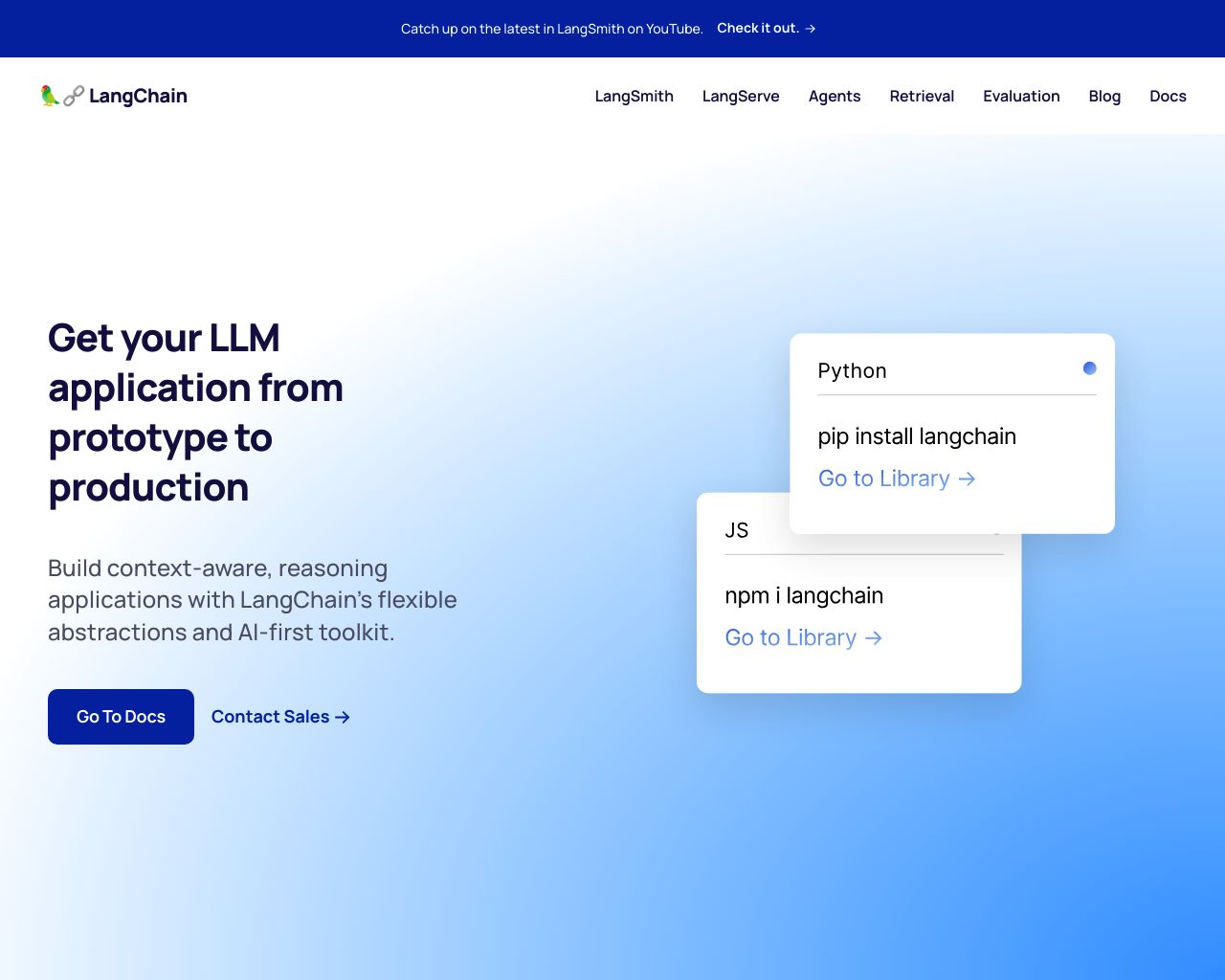AI-powered task management and application development tools reshape how businesses operate and innovate. BabyAGI, LangChain, and SmythOS represent cutting-edge solutions in this space, each offering unique approaches to harnessing AI capabilities. This comparison delves into the strengths and limitations of these platforms, exploring their core features, ease of use, and potential applications across industries. Whether you’re a developer seeking powerful AI frameworks, a business leader looking to streamline operations, or an AI enthusiast exploring new possibilities, understanding the nuances of these tools will help you make informed decisions about integrating AI into your projects and workflows.
BabyAGI Overview
BabyAGI revolutionizes task management through autonomous AI agents. This open-source platform empowers developers to create intelligent systems capable of generating, prioritizing, and executing tasks without human intervention. BabyAGI’s core strength lies in its ability to break down complex objectives into manageable subtasks, learning and adapting as it progresses.
BabyAGI revolutionizes task management through autonomous AI agents… capable of generating, prioritizing, and executing tasks without human intervention.

BabyAGI leverages advanced natural language processing and machine learning techniques to simulate human-like cognitive processes. By integrating memory and context handling through Pinecone, a vector database, the system efficiently stores and retrieves task results. This feature enables BabyAGI to maintain continuity and learn from past experiences, enhancing its problem-solving capabilities over time.
BabyAGI leverages advanced natural language processing… to simulate human-like cognitive processes. By integrating memory… the system efficiently stores and retrieves task results.
The platform excels in autonomous task generation, adapting to new challenges much like a human would. This makes BabyAGI particularly valuable for complex problem-solving across various industries, from healthcare to education. For instance, in healthcare, it can analyze patient data to suggest personalized treatment plans, while in education, it can create tailored learning experiences for individual students.
The platform excels in autonomous task generation… for complex problem-solving across various industries, from healthcare to education.
Despite its impressive capabilities, BabyAGI has limitations. The platform lacks a visual builder or no-code editor, requiring users to have coding knowledge, particularly in Python. Additionally, it doesn’t offer features like multi-agent collaboration, human-AI interaction tools, or specific debugging modes. These constraints may limit its accessibility for non-technical users and its application in scenarios requiring direct human oversight or collaboration between multiple AI entities.
LangChain Overview
LangChain empowers developers to build sophisticated applications powered by large language models (LLMs). This open-source framework simplifies the entire LLM application lifecycle, from development to deployment. LangChain’s modular approach provides building blocks and integrations that accelerate the creation of AI-driven solutions.
At its core, LangChain offers a suite of tools for working with LLMs. The framework includes LangGraph for building stateful agents, LangSmith for monitoring and optimizing performance, and LangServe for deploying applications as APIs. These components work together seamlessly, enabling developers to focus on crafting intelligent solutions rather than wrestling with infrastructure.
LangChain empowers developers to build sophisticated applications powered by large language models (LLMs). This open-source framework simplifies the entire LLM application lifecycle, from development to deployment.
LangChain stands out for its flexibility and extensive ecosystem. The framework supports various LLMs, prompt templates, and retrieval methods, allowing developers to tailor solutions to their specific needs. Its libraries cover core abstractions, community integrations, and partner-specific packages, fostering a rich development environment. The LangChain Expression Language (LCEL) provides a declarative way to chain components, offering advantages like streaming support and optimized execution.

While LangChain excels in providing a comprehensive toolkit for LLM application development, it may present a steeper learning curve for those new to AI development. The framework’s power comes with complexity, requiring users to understand various concepts and components to fully leverage its capabilities. Additionally, as an open-source project, enterprise-grade support and certain advanced features found in commercial platforms may be limited.
LangChain stands out for its flexibility and extensive ecosystem. The framework supports various LLMs, prompt templates, and retrieval methods, allowing developers to tailor solutions to their specific needs.
LangChain integrates well with popular AI models, databases, and APIs, making it adaptable to diverse tech stacks. Its ability to work with various data sources and output formats enhances its versatility across different use cases. However, users should be prepared to invest time in understanding the framework’s architecture and best practices to maximize its potential.
Feature Comparison
BabyAGI and LangChain approach AI development from different angles. BabyAGI focuses on autonomous task management, breaking complex goals into subtasks. LangChain provides a flexible framework for building applications powered by large language models (LLMs). This fundamental difference shapes their feature sets and use cases.
In core components, BabyAGI excels at autonomous operation. It generates, prioritizes, and executes tasks without human intervention, learning from past results to improve future performance. LangChain, while not inherently autonomous, offers powerful tools like LangGraph for building stateful agents and LangSmith for monitoring and optimizing LLM applications. LangChain’s modular approach allows developers to construct sophisticated AI solutions, but requires more hands-on development compared to BabyAGI’s out-of-the-box task management.
Security features highlight another key difference. BabyAGI’s documentation lacks explicit mentions of security measures like data encryption or access controls. LangChain, designed for broader application development, integrates with various LLMs and APIs, necessitating robust security practices. While neither platform offers comprehensive built-in security, LangChain’s ecosystem likely encourages developers to implement appropriate safeguards when building production-ready applications.
Feature Comparison Table
| BabyAGI | LangChain | SmythOS | |
|---|---|---|---|
| CORE FEATURES | |||
| Hosted Agents (Dev, Production) | ❌ | ✅ | ✅ |
| Environments (Dev, Production) | ❌ | ✅ | ✅ |
| Visual Builder | ❌ | ❌ | ✅ |
| No-Code Options | ❌ | ❌ | ✅ |
| Explainability & Transparency | ❌ | ✅ | ✅ |
| Human-AI Interaction | ❌ | ✅ | ✅ |
| Audit Logs for Analytics | ❌ | ✅ | ✅ |
| Agent Work Scheduler | ❌ | ❌ | ✅ |
| Logs & Monitoring | ❌ | ✅ | ✅ |
| SECURITY | |||
| Constrained Alignment | ❌ | ❌ | ✅ |
| IP Control | ❌ | ❌ | ✅ |
| COMPONENTS | |||
| Foundation AIs | ❌ | ✅ | ✅ |
| Zapier APIs | ✅ | ❌ | ✅ |
| Data Lakes | ❌ | ❌ | ✅ |
| DEPLOYMENT OPTIONS (EMBODIMENTS) | |||
| Deploy as Webhook | ✅ | ❌ | ✅ |
| Staging Domains | ❌ | ❌ | ✅ |
| Production Domains | ❌ | ❌ | ✅ |
| Deploy as Scheduled Agent | ❌ | ❌ | ✅ |
| DATA LAKE SUPPORT | |||
| Hosted Vector Database | ✅ | ❌ | ✅ |
| Sitemap Crawler | ❌ | ❌ | ✅ |
| YouTube Transcript Crawler | ❌ | ❌ | ✅ |
| URL Crawler | ✅ | ❌ | ✅ |
| Word File Support | ✅ | ❌ | ✅ |
Best Alternative to BabyAGI and LangChain
SmythOS emerges as the superior alternative to BabyAGI and LangChain for AI agent development and automation. Our platform combines the strengths of both competitors while addressing their limitations, offering a comprehensive solution for businesses and developers.
We provide a visual drag-and-drop interface that simplifies AI agent creation, eliminating the need for extensive coding knowledge. This approach democratizes AI development, allowing users to build sophisticated agents without sacrificing functionality. Unlike BabyAGI’s narrow focus on task management or LangChain’s developer-centric framework, SmythOS delivers a versatile platform suitable for various AI applications.
SmythOS emerges as the superior alternative to BabyAGI and LangChain for AI agent development and automation. Our platform combines the strengths of both competitors while addressing their limitations…
Our extensive integration ecosystem sets us apart. SmythOS supports a wide array of APIs, AI models, and tools, including popular services like Slack, GitHub, and Stripe. This flexibility ensures seamless incorporation into existing workflows and business processes. While BabyAGI and LangChain offer some integrations, they lack the breadth and depth of our ecosystem.
SmythOS excels in deployment options, a critical area where our competitors fall short. We enable users to deploy AI agents across multiple platforms, including Google Vertex, Microsoft Copilot, and Amazon Web Services Bedrock. Additionally, our agents can function as ChatGPT plugins or Alexa skills, providing unparalleled versatility. This deployment flexibility, combined with our robust hosting and environment management, ensures that AI solutions can be seamlessly integrated into any system.
Security and scalability form the backbone of SmythOS. We implement advanced features like constrained alignment, data encryption, and IP control, addressing the growing concerns around AI safety and data protection. Our platform scales effortlessly to meet enterprise-level demands while maintaining performance and reliability. These aspects give SmythOS a significant edge over BabyAGI and LangChain, particularly for businesses prioritizing security and growth potential in their AI initiatives.
Conclusion
BabyAGI, LangChain, and SmythOS each offer unique approaches to AI development and task management. BabyAGI excels in autonomous task generation and execution, making it valuable for complex problem-solving scenarios. LangChain provides a flexible framework for building LLM-powered applications, offering extensive tools for developers. However, SmythOS emerges as the superior choice, combining ease of use with powerful features.
SmythOS’s drag-and-drop interface enables users to create sophisticated AI workflows without extensive coding knowledge. Its support for over 300,000 integrations surpasses the capabilities of both BabyAGI and LangChain, allowing for seamless connection with various data sources, APIs, and AI models. The platform’s multi-agent orchestration and versatile deployment options, including the ability to deploy agents anywhere, provide unparalleled flexibility and scalability.
While BabyAGI and LangChain have their strengths, SmythOS offers a more comprehensive solution for businesses and developers looking to harness the power of AI. Its intuitive design, extensive feature set, and focus on security make it an ideal choice for those seeking to innovate and automate processes efficiently. To experience the full potential of AI development and deployment, explore SmythOS’s diverse range of AI-powered agent templates and see how it can transform your workflow.